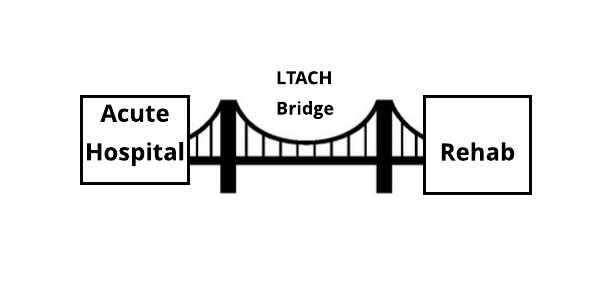LTAC Hospitals are specifically designed to treat complex patients in a post-acute care setting for an extended period of time. I tell my patients that an LTAC is a “bridge” between an acute hospital setting and a rehab facility.
For example, patients may no longer have urgent or critical needs. However, they still have acute and complex needs that a rehab facility cannot address appropriately. An LTAC is a great solution. They have a care team composed of: physicians, nurses, therapists, pharmacist, dieticians and case managers. Similarly to a regular hospital, the care team is there to coordinate exceptional care to patients.
I’m going to tell you about the We’ll discuss the differences between LTAC, Acute hospital and rehab. In addition I’ll go over the criteria for an LTAC, and what you can expect for care.
Top Differences Between an LTAC and Acute Hospital
Specific testing, procedures and surgeries are available in an acute hospital setting. These services are specialized and are typically not available in a rehab setting.
An Acute Hospital is NOT a long term solution to ANY medical problem. There is simply not enough beds to house everyone for their recovery periods. Also, insurance often does not pay for an extended acute hospital stay. An acute hospital stay on average is between 3 and 4 days. The goal is to medically stabilize the patient to start recovery. Now its time for the next level of care.
There are times when a patient has several medical conditions and complex issues. Sometimes it may prevent them from being able to fully participate in extensive rehabilitation. As a result, complex issues require similar staffing and care that you find in the current acute hospital setting. However, they may need extended medical care that will be longer than the 3-4 day acute hospital stay.
These patients also no longer need specific procedures or surgeries that require intensive specialty monitoring. However, they need continued hospital level of care for an extended period of time. LTAC bridges the gap between a hospital level of care to a rehab level of care.
Criteria for LTAC
The very first thing a patient’s hospital care team does is discuss the patient’s current condition and determine what the next best level of care might be. The following criteria is what we use to determine if LTAC is the best post acute care option for a patient, and it’s also the criteria insurance looks at to determine if they will be willing to pay for LTAC level of care.
- The patient has complex respiratory needs. ie, invasive or non-invasive ventilator management, new tracheostomy placement, or high flow oxygen needs
- A patient requires long-term and intensive management of IV nutrition, IV antibiotics or IV pain medication
- A patient has complex wound care needs that require regular and intensive monitoring and treatment. Examples include: multiple pressure ulcer wounds, complex surgical wounds, Osteomyelitis, Diabetic ulcers, Post Trauma wounds and severe burns. Often times these wounds are at high risk for infection which can lead to sepsis.
- A patient requires continued dialysis and kidney function monitoring
- A patient needs Physical, Occupational and Speech Therapy to reduce atrophy and increase bed mobility and physical function
*It’s important to note, that only meeting ONE of these 5 criteria is often not enough. Patients need to meet 2-3 of these criteria to get accepted to LTAC and have insurance pay for their stay.
Insurance Approval for LTAC
After the medical team agrees that the patient meets a minimum of 2-3 criteria listed above, the social worker or case manager will send a referral to an available LTAC in the area with the approval of the patient or their representative.
The LTAC admissions coordinator reviews the medical records with their medical staff to ensure they can meet the patient’s needs and then they submit a request to the patient’s insurance for pre-authorization. That request can take 1-3 days to get authorized depending on the insurance company. Medicare does not require pre-authorization.
Finally, the LTAC and hospital social worker will work together to arrange transportation to the facility.
What to Expect During an LTAC Stay
The average length of stay at an LTAC is 25 days. The stay can be more than 25 days or less than 25 days depending on their progress and insurance approval.
Within 24 hours of a patient’s admission to an LTAC, they are assessed by a nurse to determine their current medical condition and needs. Additionally, they are then introduced to their medical care team and a plan of care has been initiated.
Within 48 hours of admission (if it’s during the weekday) a care plan meeting should be initiated by the social worker or case manager. This is a meeting that allows the patient, their family/representative to meet their medical team face to face. They will discuss goals and anticipated plan of care. This is an important time for the patient and family/representative to voice any concerns and their discharge goals to the team. It is VITAL to voice these sooner than later so that the team can address it quickly and accurately.
If you wait until the day of discharge or the week before discharge, then the team doesn’t have a chance to meet your expectations or help you get to your particular goals. So take ADVANTAGE of these meetings! They also occur 14 days after admission and 21 days after admission.
Your Care Team
The medical care team will work with you daily to help meet your discharge goals. Goals can include discharging home with home health care or continuing rehab at another facility.
Physical, occupational or speech therapy typically occurs 3-4 days a week, sometimes more depending on their care plan. A physician will round on the patients daily.
In addition, Respiratory therapists, Pharmacists, Dietitians and Case managers will also round several times a week or daily. Nursing staff is present 24 hours a day, 7 days a week. They administer medications and fulfill the orders placed by the physician.
The Social Workers and Case Managers start planning for a successful discharge that may occur way later AND they work with the patient’s insurance company to ensure payment.
My Personal LTAC Experience
I worked as a Social Work/Case Manager at an LTAC facility, and my role there was similar to my role in an acute hospital setting.
The Social Work/Case Manager additionally works with the patient’s insurance company to maintain authorization of payment for the LTAC stay.
Every 3 days or weekly (depending on the demands of the insurance company), as the Case Manager, I was required to submit updated medical records to insurance.
The insurance company requires medical records to prove that the patient needs continued care at the LTAC. They must show the insurance company that they still meet the admission criteria AND they are showing progress to improvement.
Check out these posts to learn more about health insurance, specifically medicare:
Services Covered By Medicare Part A
Why You Should Care About Medicare Part B
Prescription Coverage Through Medicare Part D
How to Fill in the Gaps of Healthcare Coverage with Medigap
Remember, an LTAC is still a HOSPITAL, so the goal is still to get a patient to the point where they can be close to or back at their baseline level of functioning at home. The LTAC is just a bridge to the next step. The next step after recovery is rehabilitation.
Questions?
If you have any questions about this post or want to talk to me about your specific situation, I’d love to hear from you!


No responses yet